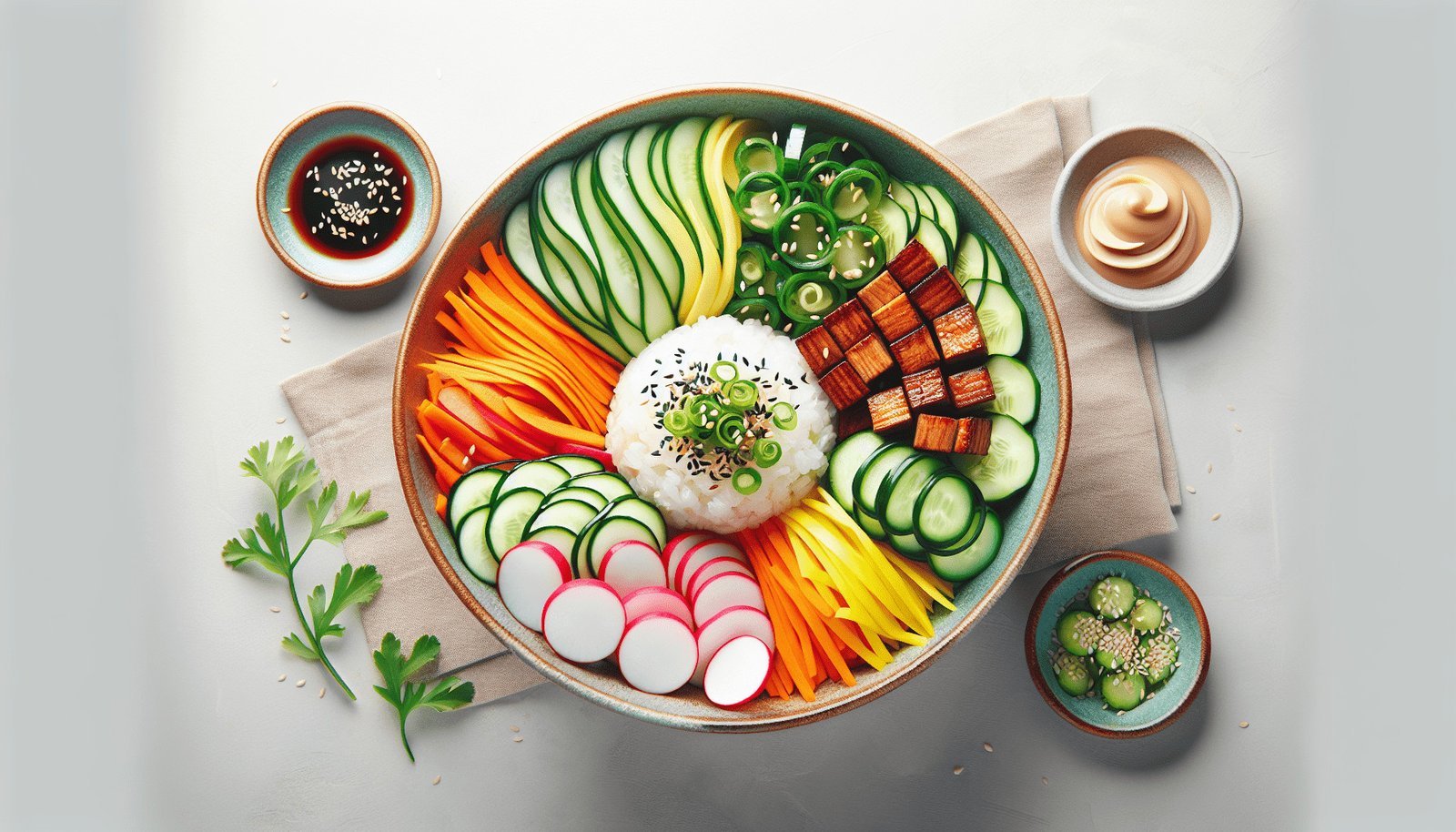Have you ever wondered how to create trendy and visually appealing Korean-inspired bowls? These delightful food creations have become a favorite among food enthusiasts around the world. Their vibrant colors, balanced flavors, and nutritional benefits make them an exceptional dish to have in your culinary repertoire. Despite their elaborate appearance, crafting these bowls is an approachable process that combines creativity with a touch of tradition.
Understanding the Essence of Korean-Inspired Bowls
Korean-inspired bowls, often referred to as “buddha bowls” or “bibimbap,” draw inspiration from the harmony of flavors and textures found in traditional Korean cuisine. They not only taste amazing but also present a feast for the eyes. These bowls typically comprise a variety of ingredients layered or arranged beautifully in a bowl. Here, we’ll explore what makes these bowls so special.
The Vibrancy of Korean Flavors
At the heart of Korean cuisine are bold and distinctive flavors. You’ll often find a blend of sweet, spicy, tangy, and umami in a single dish. Ingredients like gochujang (fermented chili paste), sesame oil, and soy sauce are staples that contribute to these complex flavors. When building your Korean-inspired bowl, understanding these flavors can help you create an authentic and exciting taste experience.
The Visual Appeal
The visual aspect of Korean-inspired bowls is as important as the taste. Traditionally, a variety of colorful vegetables, proteins, and grains are artfully arranged to create an aesthetically pleasing dish. The use of vibrant ingredients not only enhances the overall appeal but also signifies a balanced intake of nutrients.
The Importance of Balance
Creating a Korean-inspired bowl is about achieving the right balance—nutritionally, flavor-wise, and visually. This involves a thoughtful combination of carbohydrates, proteins, and vegetables, ensuring that the meal is both satisfying and healthy. This focus on balance is what makes these bowls particularly popular in health-conscious communities.
Selecting Ingredients for Your Korean-Inspired Bowl
Choosing the right ingredients is crucial when crafting your bowl. You want to aim for a mixture that is both delicious and nutritionally balanced. Let’s break down the essential components that make a Korean-inspired bowl complete.
Rice or Grains: The Foundation
The base of your bowl is typically a type of rice or grain. While traditional Korean dishes use white rice, you can experiment with other grains like brown rice, quinoa, or even cauliflower rice for a lower-carb option. The grain acts as the foundation, providing bulk and simple carbohydrates to your bowl.
Proteins: The Heart of the Meal
Korean-inspired bowls often feature a variety of proteins. Here are some common options:
- Beef: Marinated bulgogi or grilled beef strips.
- Chicken: Often marinated in soy sauce, garlic, and ginger for a flavorful punch.
- Tofu: A great vegetarian alternative, often grilled or stir-fried.
- Eggs: A fried or poached egg adds richness and texture.
Vegetables: The Colorful Touch
The inclusion of vegetables brings color, texture, and essential vitamins. Common choices include:
| Vegetables | Description |
|---|---|
| Kimchi | Fermented vegetables, often Napa cabbage. |
| Carrots | Julienne or thinly sliced for crunch. |
| Spinach | Blanched and seasoned with sesame oil. |
| Cucumbers | Fresh and hydrating, thinly sliced. |
| Mushrooms | Stir-fried for a savory element. |
Sauces and Dressings: The Finishing Flavors
Sauces are integral to Korean-inspired bowls, adding moisture and flavor. Some popular options include:
- Gochujang Sauce: A spicy-sweet Korean chili paste.
- Soy Sauce Dressing: A blend of soy sauce, sesame oil, and vinegar.
- Sriracha mayo: For a creamy and spicy addition.

Techniques to Assemble Your Korean-Inspired Bowl
Once you have your ingredients ready, the next step is assembling them in a way that is both practical and visually appealing. Let’s discuss some techniques to help you make a beautifully composed bowl.
Layering: A Logical Approach
Consider layering your ingredients to ensure every bite contains a variety of textures and flavors. Start with the base of grains, followed by your choice of protein. Add vegetables in sections or clusters, ensuring the colors complement each other.
Arranging for Visual Appeal
When arranging your ingredients, focus on symmetry and a pleasing color palette. Use contrasting colors and different shapes to make the bowl visually striking. For instance, place julienne carrots next to sliced cucumbers and marinated mushrooms to create a vibrant pattern.
Garnishing: The Final Touch
Finish your bowl with garnishes to elevate its appearance and taste. Common garnishes include sesame seeds, chopped green onions, and a drizzle of your chosen sauce. These elements provide a polished look and an additional layer of flavor.
Enhancing Your Korean-Inspired Bowl
Now that you’ve mastered the basics, consider ways to enhance your bowl to create a unique dining experience.
Texture Variations
Incorporating a variety of textures makes the bowl more enjoyable. Add crispy fried shallots, toasted nori sheets, or nuts like almonds or peanuts for crunch. These ingredients can add unexpected texture contrasts that elevate the overall dish.
Experimenting with Ingredients
Feel free to break away from tradition and incorporate non-Korean ingredients that fit well with the bowl. Consider adding avocado for creaminess or edamame for extra protein. The key is to maintain the balance and not overpower the core Korean flavors.
Seasonal Changes
Switch up your ingredients with the seasons. Using seasonal produce not only keeps your bowls fresh and exciting but also ensures peak flavor and nutrition. In spring, you might use asparagus, while fall offers a chance to incorporate roasted sweet potatoes.

The Nutritional Benefits of Korean-Inspired Bowls
Korean-inspired bowls aren’t just delicious; they also come packed with numerous health benefits. Let’s explore what makes these meals a healthy choice.
Balanced Macronutrients
These bowls provide a balanced mix of macronutrients: carbohydrates from grains, proteins from meat or tofu, and fats from cooking oils and dressings. This balance is essential for maintaining energy levels and supporting overall health.
Rich in Micronutrients
The variety of vegetables ensures you’re getting a wide range of vitamins and minerals. From the vitamin A in carrots to the iron found in spinach, these ingredients promote a healthy immune system and overall well-being.
High in Fiber
The use of whole grains and fresh vegetables contributes to a high fiber content, which aids in digestion and helps keep you feeling full and satisfied long after the meal is over.
Catering to Dietary Preferences and Restrictions
One of the great things about Korean-inspired bowls is their adaptability. You can easily modify them to cater to various dietary needs, making them accessible to everyone.
Vegan or Vegetarian Options
To craft a vegan or vegetarian bowl, omit animal proteins and substitute with plant-based ones. Tofu, tempeh, or legumes can supply essential proteins. Ensure that any sauces or dressings used are also free from animal products.
Gluten-Free Choices
For a gluten-free bowl, ensure that your grains, like rice or quinoa, meet your dietary needs, and choose tamari over regular soy sauce. Many of the traditional elements in these bowls are already gluten-free.

Troubleshooting Common Challenges
Even with the best-laid plans, you might encounter a few hiccups while creating your Korean-inspired bowl. Here are some issues you might face and tips to solve them.
Overcooked or Undercooked Rice
Achieving the perfect rice texture is crucial. Always rinse your rice thoroughly before cooking and follow the recommended water-to-rice ratios for your specific type of rice. If your rice is too dry, adding a bit of water and steaming it further might help.
Clashing Flavors
Too many bold flavors can result in a confusing taste profile. When choosing sauces, pick one bold option and balance it with milder flavors. If your bowl ends up too spicy, a dollop of yogurt or a spoonful of avocado can help tone it down.
Lack of Visual Appeal
If your bowl seems visually unappealing, it’s often a matter of rearranging the ingredients. Pay attention to the color wheel, placing complementary colors next to each other and avoiding clashing hues. Garnishing with fresh herbs or seeds can also add a fresh touch and brighten up the dish.
Embracing the Art of Korean-Inspired Bowls
Creating trendy and visually appealing Korean-inspired bowls is an art as much as it is a culinary endeavor. With each bowl, you have the opportunity to express creativity and explore new flavor profiles, all while enjoying a satisfying and healthy meal. The key is to embrace the process and learn along the way, adapting to both traditional ingredients and those that inspire you personally.
Final Thoughts
While there’s no one right way to create a Korean-inspired bowl, the focus should remain on balance and enjoyment. By mixing traditional Korean flavors with your personal preferences, you can create a dish that is not only beautiful but deeply satisfying. Enjoy the culinary journey, and remember that each bowl you create tells a story of flavors, cultures, and creativity.

